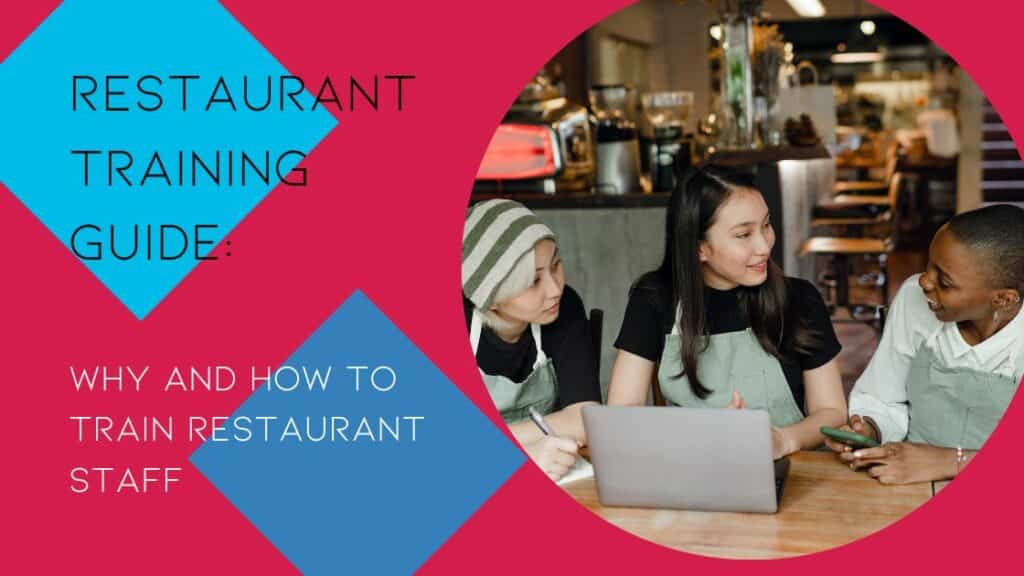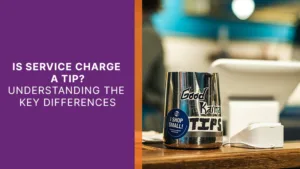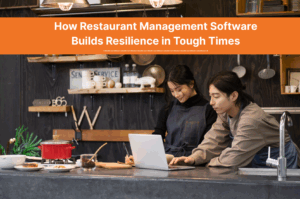Updated on: June 21, 2024
In the hospitality industry, the guest experience can make or break a business.
While it may seem like something that gets put on the back burner, training your staff should be at the forefront of your mind if you own or manage a restaurant. While at first restaurant training may not seem to directly correlate with increasing sales and revenue, keep in mind that the staff and servers are the first customer touchpoint.
No matter how talented team members are, it takes the right training process to put an entire team on the same page and make any collaborative effort successful. This is true of team sports, and it’s definitely true in the case of the restaurant industry. You could compile the most talented restaurant workers in the world, but without an efficient restaurant training system in place, the result is typically a chaotic, lackluster effort.
Great service equals happy customers, which leads to great reviews, and in turn more sales. A well trained staff is looking much more important now, right? Understanding the need for training puts you on the right track, however actually training your staff is easier said than done. It’s vital to the success of any restaurant that the training is well-thought-out, easy to follow, repeatable, and as straightforward as possible. Your restaurant training could be the single most important component regarding your staff.
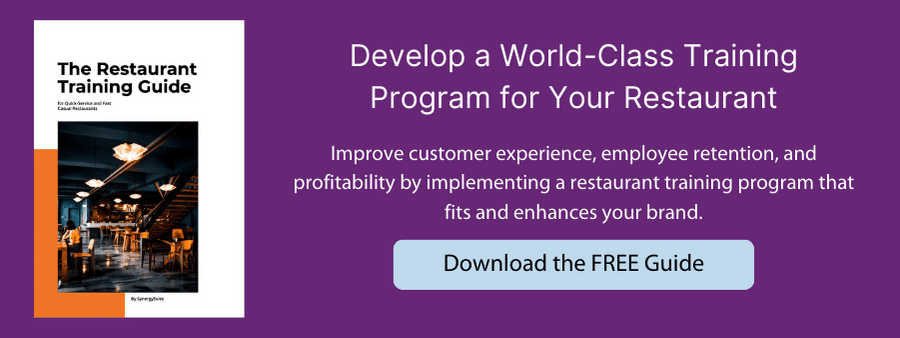
What is Restaurant Training?
Restaurant training is the system any given food establishment has in place that outlines the rules, regulations, expectations, and workflow that every employee must follow.
There are many aspects that go into a great restaurant training program. These include mastering product knowledge, teaching servers to sell, food handling, smoother operations, facility care, compliance, safety procedures, and even team building and teamwork. There’s a lot that goes into a great restaurant training program.
You may assume training is only for newly hired employees, however, the best restaurants implement continual training for all employees. Continual or ongoing training helps staff feel needed and challenged. This leads to an increase in loyalty as well as productivity.
Why is Restaurant Training Important?
It Improves Employee Experience and Retention
With challenges in the labor market right now, hiring and then retaining good staff is necessary to ensure business growth.
Implementing a quality restaurant staff training program is one of the top drivers when it comes to staff retention. A trained staff not only means happy customers—it also results in higher employee morale. Investing time into training communicates with your staff members that they’re valued, that you expect them to be around awhile, and ensures that everyone is on the same page.
Oftentimes when there’s not a set training plan, clear communication of expectations is absent and said expectations end up going unmet. This can lead to unfulfilled staff and a high turnover rate. When great training programs are set, consistent, and individualized your restaurant staff will better understand their roles and how to effectively execute them.
It Improves Customer Satisfaction
A successful restaurant thrives on a repeatable, standardized restaurant training program.
The more the system is practiced and perfected, the more enjoyable the employee and customer experience becomes. Restaurants are fast-paced environments. Orders must be taken quickly. Customers want their food promptly. And when it’s time to pay, they don’t want to wait around.
Running a restaurant successfully can be a daunting task. There are so many working arms involved that it takes a specific system and structure to achieve a great customer experience. This is the basic idea of deploying a training program.
Your restaurant training, and system in general, must be created in a way that, when properly executed, leads to everything running like a well-oiled machine. The rewards of an efficient training system include satisfied customers, favorable reviews, a positive work environment, increased revenue, and an increase in your wait staff’s tips. However, failure to execute the system outlined in your training could potentially manifest disastrous results.
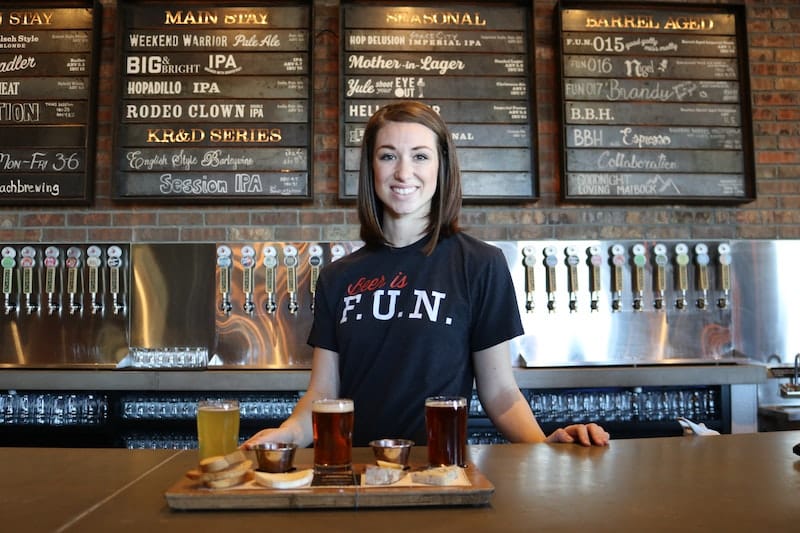
What Are the Consequences of Poor Restaurant Training?
The potential consequences are seemingly endless for a restaurant staff that doesn’t receive the proper training. However, the most common negative results include:
Poor Customer Service
The customer suffers the most without a uniform system for the kitchen and the front of the house.
Training must outline the ideal customer experience from beginning to end. Poor customer service could mean a variety of things, including lack of check-ins/drink refills, extended waiting for a table or for food to be prepared, unsatisfactory food quality, an unsanitary environment, and more. It’s not always easy to work with people. This means customer service training is necessary to help your employees interact with all types of people.
Inconsistent Restaurant Culture
Your restaurant culture is basically a reflection of the mindset of your restaurant business. This includes how employees interact with one another, the respect level present within your organization, and the overall environment, both away from the customers and while interacting with them. With no system to follow and no outline to adhere to, your restaurant culture is an unknown factor that will take a life of its own, and produce unexpected results. Your restaurant culture is vital to your business, and so it will always be best to deliberately outline and create that culture.
Inefficiency and Mistakes
When your employees lack a repeatable system to follow, inefficiency and mistakes become a regular occurrence.
Employees can’t be expected to operate flawlessly when no standardized practice or system is followed. You end up with a group of individuals freestyling, resulting in inconsistent work output. One shift might be good, the next might be just okay, and the next could be terrible. A general lack of consistency is a direct path to a failing restaurant 99% of the time.
A comprehensive training program from opening to closing procedures, food safety procedures to customer interaction etiquette guidelines and everything in between can prevent many mistakes and improve efficiency.
High Employee Turnover
Employee retention is a perennial issue in this industry. Because of this, investing time and resources into training restaurant employees may seem like a waste of time, but don’t fall into this trap!
Employees you hire, especially those who have experience, will be turned off by a lack of organization and a concrete system in place.
Regardless of what anyone says, almost all employees want to be part of something special. People take pride in their work when they know they’re providing a valuable service. Without something to take pride in and the frustrations of an inefficient system, get used to a constant cycle of hiring, quitting, and rehiring.
Onboarding training and continuous training: in addition to making employees better at their jobs, these efforts can build expertise and create a great culture that helps team members feel like they’re part of something.
Characteristics of a Quality Restaurant Staff Training Program
There are certain signs that identify the presence of a quality restaurant staff training program.
Consistency
The best training programs implement consistent and regular training.
While new employees will expect to have a significant block of training when they are first starting, the training shouldn’t stop there. Training should continue all the time, consistently improving your processes and the skills of your employees.
Documented
Everything is documented and logged for a certain level of organization and efficient communication. Tasks and shifts are documented, in addition to any additional information vital to success.
Complete
A restaurant with the proper training in place will feel complete.
This means that the employees will have a clear understand of what is expected of them, and how to do their jobs, without confusion. A “complete” training program doesn’t mean the training should end or that there isn’t more training needed, but that all the essential points for doing the job are covered and can be built upon through additional training.
Personalized, When Needed
The best training, while consistent across your organization, isn’t entirely one-size-fits-all. People have different learning styles so training should be personalized for each employee in your organization.
While the general topics might be uniform across the organization for different roles, each person will learn differently, and will have different training needs than the others. Don’t just stick some training videos in an old DVD player. To make the best use of your training program and improve knowledge retention, managers and trainers should be able to adjust the training methods to best help the employee learn.
Continuous
An effective training program is an ongoing training program. Your training system should be a continuing process open to changes and small adjustments.
The last thing you want is to stagnate and for your employees to become complacent. Just because your staff is well-versed in your system doesn’t mean there’s no room for adjustments. And, just because your training program works doesn’t mean it can’t be improved upon. Always continue to look for new ways to improve on your training, and you’ll see the benefits in your organization.
Evolution
As time passes, there should always be room for your organization to evolve.
This means your training system will evolve over time as well. This doesn’t mean you should stray from the central points that made your success possible in the first place – you want to keep your winning formula. However, evolution is a part of business; you will slowly die without growth.
Creating a Restaurant Training Manual
Creating a restaurant training manual will be a completely different process from one organization to the next. However, the outline generally remains the same, with different specifics depending on your brand.
Why a Training Manual Is Vital
Creating a training manual gives your team a clear structure to your training program. It contains documented material that can be referred to at any time, and ensures that essential training topics and steps aren’t overlooked. A training manual is also a great opportunity for you to clearly state what is important to your brand, and makes your expectations, rules, and processes uniform across all your locations.
What to Include In Your Restaurant Training Manual
Specific additions and changes will be distributed throughout your training manual, but the following areas are usually outlined in restaurant training and have a powerful effect on your team.
- Restaurant Story
- Mission Statement
- Guest and Customer Service Principles
- Dress Code
- Food and Kitchen Safety Requirements
- HR Procedures and Policies
- General Pay and Benefits Information
Learn more about the ins and out of restaurant training manuals: Creating a Restaurant Training Manual
Onboarding New Restaurant Employees
Whenever a new employee starts working at your business, there is a lot of training material to cover. One of the best ways to help your new employee to love their new job is to make sure that the onboarding process and initial training is well thought-out and smooth.
Orientation and Education
The first step to the onboarding training is orientation and brand education. Basically you want your new employee to feel like they know who they’re working for, and what their new environment will be. This step will include covering topics like:
- A general overview and summary of restaurant policies from the restaurant training manual. If a digital training manual is available, make sure all employees know how to access it.
- A thorough review of all the staff, departments, and roles within the restaurant
- A menu discovery section for new hires to get familiar with the items you offer. This must be memorized.
- Restaurant layout. This is more important for servers, but it’s also helpful for kitchen staff. This helps new wait staff members navigate the floor efficiently and avoid accidents.
- Restaurant technology should have a dedicated section. This includes any POS sales hardware and software and any important integrations that ties into daily employee events like logging hours, schedule requests, shift work, etc.
Demonstration
After thoroughly digesting the training manual, first-hand demonstrations, shadowing, and hands-on learning are the next steps.
- You should have designated employees with ample experience to provide 1-on-1 demonstrations of special focus areas (cooking, customer interaction, anything that’s considered “your brand’s way”).
- Cross-training with more than one employee for additional perspective
Shadowing
- Shadowing experienced employees during actual shifts provides the building blocks for their first days of solo work
- After hitting a point of understanding and confidence, flip the roles and allow a veteran employee to shadow the new hire
Test Shift
Allow each new hire to run a test shift. This should be during a slower shift, but not slow enough to avoid challenging them.
Feedback and Improvement
Their primary trainer should log performance notes and provide each employee with an assessment that includes feedback for performance improvement.
To learn more about restaurant employee onboarding, visit our blog on the topic here: Restaurant Employee Onboarding: How-to and Common Topics
Restaurant Training for Specific Job Roles
Organization Chart: Typical Job Roles in QSR and FCR Establishments
A common organization chart for a quick service restaurant (QSR) usually includes the following positions:
- Franchise or Store Owner/Operator: Responsible for the overall management and operation of the restaurant.
- General or Store Manager: Oversees the day-to-day operations of the restaurant, including staff management, inventory, and customer service.
- Assistant Manager: This is the most ambiguous role on this list, as it could be called a number of different things, and generally has a wide range of responsibilities. Sometimes this is also rolled into the shift manager position, or there might be a “head shift manager” of sorts. Generally speaking, though, this role is to assist the General Manager with managing the restaurant’s operations, and the training for this role will be similar to the training for the General or Store Manager.
- Shift Manager: Responsible for managing staff and operations during a specific shift.
- Front-line Crew Members: Responsible for preparing and serving food, taking orders, and providing customer service.
There would be a whole other list for each of the roles within the corporate offices of a growing quick-service or fast casual restaurant business, but in this guide we’ll focus on the roles that are specific to the restaurant locations themselves.
This is a general overview, and the specific roles and titles may vary depending on the restaurant’s size and structure. Each role here could be broken down into other specific roles such as head-chef, kitchen-staff, cashiers, shift supervisors or other roles, depending on what works best for you.
Learn more about the specific topics and training for each of these job roles by checking out our articles on each position:
- Front-line crew member training
- Line and prep cook training
- Shift manager training
- Assistant and General manager training
Continuing Restaurant Training After Onboarding
After the initial training period and shadowing is complete, it’s important that the most important areas of knowledge are continuously reinforced.
Have Regular Training
Regular training sessions should be a part of all employees’ routines. Even seasoned employees that have been in your organization for years still have things to improve, and will still need to be trained on new systems, technology, procedures, and other updates to your business.
Incorporate Team Building
This includes your veteran staff in addition to your new hires. Incorporate team-building exercises to help new hires integrate into your company culture and make them feel welcome. The more your staff understands each other, the easier it will be for them to work together on a day-to-day basis.
Review the Essential Topics
Continue to go over the most important topics with your new hires, and have your long-time employees share their experience and knowledge with the team.
Choose Additional Topics Based On Needs
Depending on what needs work, additional focus areas may be included, or refresher training is recommended.
- Safety standards and regulations
- Specific skill development
- Training on new workflows or technologies
- Working a new employee into the usual flow of the team
- And more
Learn more about your continuing restaurant training program here: Continuing Restaurant Training After Onboarding
Types and Methods of Restaurant Staff Training
Understanding how to best train new employees (and provide ongoing training to those with longer tenure) can feel like an endless buffet. It’s hard to know what to choose and what will be best for your employees. But the good news about restaurant training is that just like building your menu, you can make your own training mix for best impact.
First things first, what kinds of training should you consider? While there are a virtually endless combinations of training styles, some of the main methodologies are:
- On-the-Job Training Just as it sounds, this is when you assign a new employee to shadow a current employee and learn by observation and experience.
- E-learning Training delivered in an electronic format, whether that’s at desktop computer, a phone or other electronic device.
- Instructor-led Training Also called classroom training, this typically involves a group of new hires being trained in a group by a company-provided instructor.
- Gamification Regardless of how it’s delivered, gamified training uses the principles of gaming to motivate and incentivize employee interaction and information retention.
- Self-Guided Reference Materials This type of training allows employees to learn on their own and go back to reference the training materials whenever they need a refresher.
- Microlearning Like gamification, microlearning is a format independent of how it’s delivered. The goal is to help avoid cognitive overload by breaking up the training into small pieces that are easy to understand and absorb.
Learn more about these restaurant employee training methods, including pros, cons, and tools you can use, here: Methods for Training Employees in Restaurants: Pros, Cons, and Tools
Additional Restaurant Training Topics
Soft Skill Training for Restaurant Employees
The technical skills required in a restaurant are extremely important – and without them, it’s nearly impossible for your staff to operate within the structure outlined by the company.
It’s these skills that allow an employee to efficiently carry out the procedure designed by your organization as part of your brand – “The (Your Restaurant Here) Way.”
On the other side of the coin, you have soft skills, which make up a completely different set of attributes that might be a little more difficult to teach, but are also vitally important. Soft skills entail more of the things people have learned from real-life experiences and interactions with other people and situations.
Learn more about restaurant soft skills here: Soft Skills Training for Restaurant Staff
Food Safety Training
Food safety is an important topic for everyone to know about, especially when it comes to working in a restaurant.
It’s of vital importance to the health of both employees and customers for anyone who handles food to understand and implement the fundamentals of food safety. In this article, we’ll discuss all the major questions surrounding food safety training for restaurant employees, so you can have a proper and complete food safety training program in your food business.
Learn more about the importance of food safety training, the regulations involved, and the topics to cover here: Food Safety Training Topics and Benefits
Knife Safety Training
If you work in a restaurant, you’re guaranteed to be around knives.
While a quality knife is a valuable tool, it also inherently carries risks to the user and those around them. In this article we’ll go over knife safety training in the restaurant: what it is, why you should care, and what you should cover in your restaurant training program.
Learn more about knife safety training benefits and topics here: Knife Safety Training Topics and Benefits
Streamline and Standardize Training with Restaurant HR Software
Leveraging the power of restaurant HR software can help you build and maintain an amazing restaurant training program that can set the tone across your whole organization.
With useful tools like onboarding checklists, centralized training manual documentation, and secure communication, you can continue to refine and execute your training program without any hassle at all.
With a continued focus and reinforcement of a uniform system, new hires begin integrating within your current system alongside your long-term team members, promoting a thriving ecosystem poised for growth.
The Restaurant Training Guide
If you found this blog helpful, great!
However, it is just a blog post.
So if you feel like you have more questions and would like more help in training your restaurant staff, check our Restaurant Training Guide. It goes into greater detail about how to establish an effective, ongoing training regimen.
And, like our software, this guide is composed by people who have experience in the restaurant industry and have grappled with many of the same issues that you do. We love to help our clients succeed and we hope you’ll avail yourself of all of the tools we have to offer.

